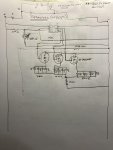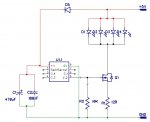I am blinking three different color LED's from C.0,C.1 and C.2 (08M2). I am using a light detecting resistor to turn on start operation at dusk and turn off at dawn. Using 4 rechargeable batteries and a 5V solar charger panel. I do have a diode to prevent reverse drain back to solar panel.
Program ran consistent but not according to code. code ran fine on simulator. Finally hooked up to 3 1.5V batteries and ran fine. Discovered the 5.3V delivered to chip from rechargeable batteries vs 4.8V(weak batteries) changed program execution!! How can this be?
I had to put 2 more diodes prior to chip to get voltage down below 5V and is working fine now.
Comments?
Program ran consistent but not according to code. code ran fine on simulator. Finally hooked up to 3 1.5V batteries and ran fine. Discovered the 5.3V delivered to chip from rechargeable batteries vs 4.8V(weak batteries) changed program execution!! How can this be?
I had to put 2 more diodes prior to chip to get voltage down below 5V and is working fine now.
Comments?




